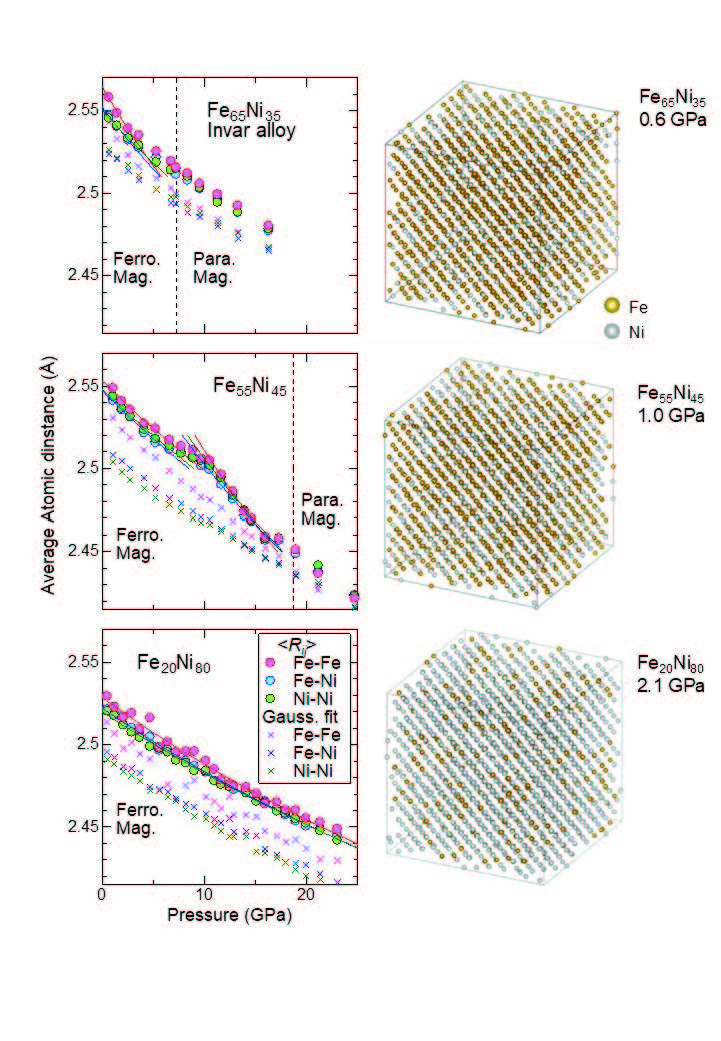Elongation and compression of Fe-Fe atomic pairs in ferromagnetic Fe-Ni alloys
Element-selective atomic-scale observations of the magnetovolume effect in ferromagnetic Fe-Ni fcc-based alloys
Elongation and rapid compression of Fe-Fe atomic pairs in Fe-Ni alloys have been probed as the atomic scale origin of the invar effect and the large magnetovolume effect in Fe-Ni disordered alloys. We investigated the Ni-content dependence of bulk modulus of Fe-Fe, Fe-Ni, and Ni-Ni atomic pairs in the fcc-based in Fe-Ni alloys using reverse Monte Carlo modeling with a dataset of extended x-ray absorption fine structure and powder x-ray diffraction under high pressure.
Small thermal expansion (α ∼ 1.19 × 10−6 /K) of Fe65Ni35 disordered alloy appears within a wide temperature range up to the Curie temperature (TC ∼ 505 K), which is widely known as the Invar effect. The magnetovolume effect at Fe65Ni35 gives rise to large volume contraction with increasing temperature and reducing magnetization, which compensates the conventional thermal expansion and consequently results in the zero-thermal expansion. On the other hand, Fe-Ni alloys with larger Ni content rapidly recover the thermal expansion of normal metal with a typical value of α ∼ 10−5 /K and higher TC. Why does the Invar effect appear in a narrow Ni content around 35 at.% of the Fe-Ni alloys?
In this study, the atomic scale origin of the invar effect and the large magnetovolume effect in Fe-Ni alloys is revisited by investigating the Ni-content dependence of bulk modulus B0 of Fe-Fe, Fe-Ni, and Ni-Ni atomic pairs using reverse Monte Carlo modeling with a dataset of extended x-ray absorption fine structure and powder x-ray diffraction under high pressure. To this end, the results of the Fe65Ni35 invar alloy were compared with those of Ni-rich ferromagnetic Fe55Ni45 and Fe20Ni80 disordered alloys.
The elongation of Fe-Fe pairs compared to the bond lengths of Fe-Ni and Ni-Ni pairs is commonly observed in the ferromagnetic states of all Fe-Ni alloys. The B0 value of each atomic pair is comparable to the value of bulk B0 when the ferromagnetic phase is stable under high pressure, while the rapid shrinkage of the elongating Fe-Fe pairs results in a smaller value of B0 at the destabilized ferromagnetic region. Therefore, the magnetovolume effect in Fe-Ni alloys is interpreted as a result of the elongating Fe-Fe pairs and their population in the alloy. The elongation and subsequent shrinkage of Fe-Fe pairs at the destabilization of the ferromagnetic order plays a crucial role for initiating the invar effect. We consider that the balance between the number of elongating Fe-Fe pairs and Curie temperature as a function of Ni content determines the appearance of the Invar effect.
Reference URL: https://journals.aps.org/prb/abstract/10.1103/b3cl-fy2t
Bibliographic Information
Elongation and compression of Fe-Fe atomic pairs in Fe-Ni invar alloys: Microscopic observations of the magnetovolume effect in ferromagnetic Fe-Ni fcc-based alloys
Naoki Ishimatsu, Yusuke Kubo, Naoto Kitamura, Naomi Kawamura, Saori Kawaguchi-Imada, and Tetsuo Irifune,
Phys. Rev. B, 112, 064109/1-8 (2025),
doi: 10.1103/b3cl-fy2t, 2025 (August 20).
Fundings
- Japan Society for the Promotion of Science (JSPS) KAKENHI Grant Number 20H05880, 21H05567, 21H01043 and 24K01148.
Media
-

Compression curves of atomic pairs and determined Fe-Ni atomic clusters.
(left) Average lengths of atomic distance evaluated by Gaussian fits (crosses) and gravity center (circles). The solid lines represent the equation of state curve based on Birch–Mrunungaham equation of state. Elongation and rapid compression of Fe-Fe atomic pairs are observed at the stable ferromagnetic region and suppressed (unstable) region, respectively. (right) Atomic clusters obtained by the reverse Monte Carlo modeling. Each cluster is viewed from the [121] direction.
credit : Ehime University
Usage Restriction : Please get copyright permission
Contact Person
Name : Naoki Ishimatsu
Phone : +81 89-927-9658
E-mail : ishimatsu.naoki.uu@ehime-u.ac.jp
Affiliation : Geodynamics Research Center, Ehime University


